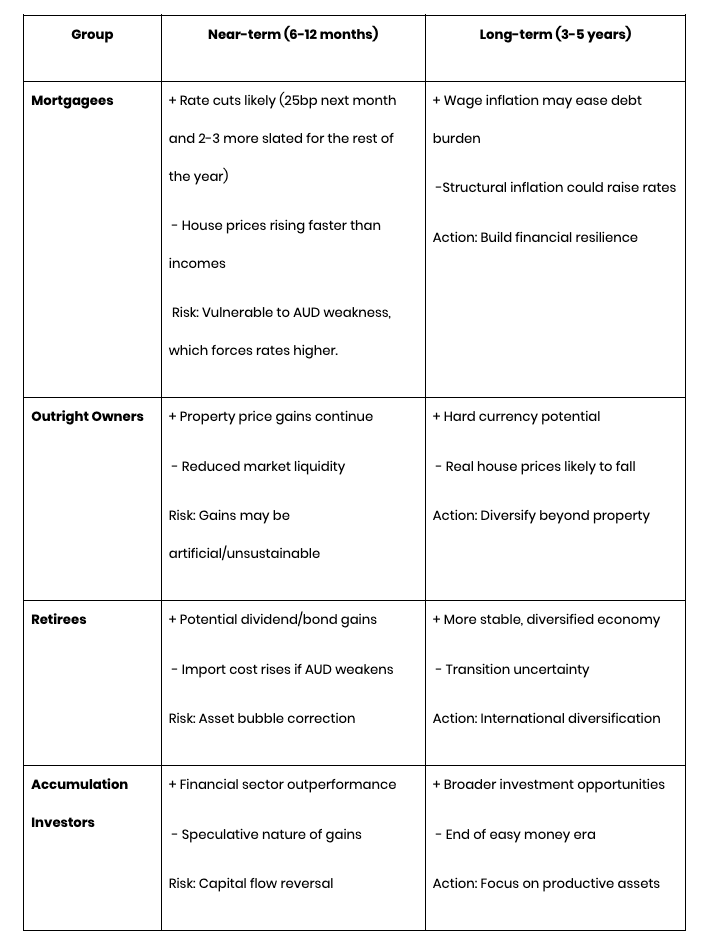Australia's Tale of Two Economies: When Financial Engineering Masks Real Economic Weakness
Australia finds itself navigating an increasingly complex economic landscape in 2025, where a speculative financial boom is masking underlying weaknesses in the real economy. This divergence presents significant challenges for policymakers and investors trying to gauge the country's true economic health.
Real Economy Under Pressure
The Australian real economy is showing clear signs of strain. While China's modest recovery in early 2025 provided temporary support for exports, this boost has proven fleeting. China's recent reduction in coal imports directly impacts Australia's commodity-dependent export sector, highlighting the economy's continued vulnerability to external demand shocks.
More troubling is the domestic situation. Despite headline improvements in household disposable income, per capita growth remains modest due to sustained high population growth. Employment creation is failing to keep pace with demographic expansion, creating a disconnect between aggregate economic data and individual living standards. Consumer sentiment reflects this reality, with households displaying marked caution about future economic prospects. Retail sales have softened, and housing market activity shows rising prices but declining transaction volumes – a concerning combination suggesting price increases driven by speculation rather than genuine demand.
The Financial Sector Mirage
Paradoxically, Australia's financial markets are experiencing a significant boom driven by substantial short-term capital inflows. These "hot money" flows, totaling billions in recent months, are being recycled by domestic banks into increased corporate lending. However, this credit expansion isn't funding productive investment or genuine economic growth.
Instead, corporations are engaging in what economists call "zaitech" – financial engineering and speculative asset purchases. Companies are borrowing not to expand operations or invest in productivity-enhancing equipment, but to acquire financial assets and engage in market speculation. This mirrors historical patterns that have often preceded financial instability, as resources flow toward speculation rather than real economic value creation.
Policy Implications and Reserve Bank Dilemma
The Reserve Bank of Australia faces a delicate balancing act. While the real economy's weakness would typically warrant interest rate cuts to stimulate growth, the speculative credit boom raises concerns about asset bubbles and financial stability. The RBA's recent decision to pause rate cuts likely reflects these concerns about excessive financial risk-taking.
The central bank's challenge is compounded by the cyclical nature of capital flows. As U.S. Treasury yields rise due to massive debt issuance expected in coming months, these speculative inflows may reverse, potentially causing currency weakness and market volatility. This could create space for rate cuts, but at the cost of financial instability.
Long-term Structural Challenges
Australia's fundamental economic challenge remains its narrow structural base. The economy has become overly dependent on a "property plus commodity" model, leaving it vulnerable to external shocks and limiting productivity growth. The current financial boom, while providing short-term support, actually exacerbates this problem by directing capital away from productive uses.
Addressing these challenges requires comprehensive policy reform focused on economic diversification and productivity enhancement. This includes removing barriers to private sector investment, encouraging innovation, and reducing dependence on commodity exports and foreign capital recycling. The goal should be creating a broader, more resilient economic base capable of generating sustainable per capita income growth.
The risk is that policymakers, distracted by financial market strength, may delay necessary structural reforms. History suggests that economies relying heavily on financial engineering and asset speculation eventually face corrections that expose underlying weaknesses. Australia's challenge is implementing reforms before such a reckoning occurs, transforming its economic model while maintaining stability.
Economic Implications by Demographic Group
To understand how these dynamics play out across different segments of the population, the table below outlines the potential near- and long-term implications for key demographic groups. It highlights the possible upsides, emerging challenges, structural risks, and actions to consider.

Key Assumptions & Risks
Near-term: U.S. Treasury yield rises trigger capital outflows; RBA responds with cuts
Long-term: Successful structural reforms broaden economy beyond "property + commodities"
Major Risk: Policy failure could perpetuate current vulnerabilities














